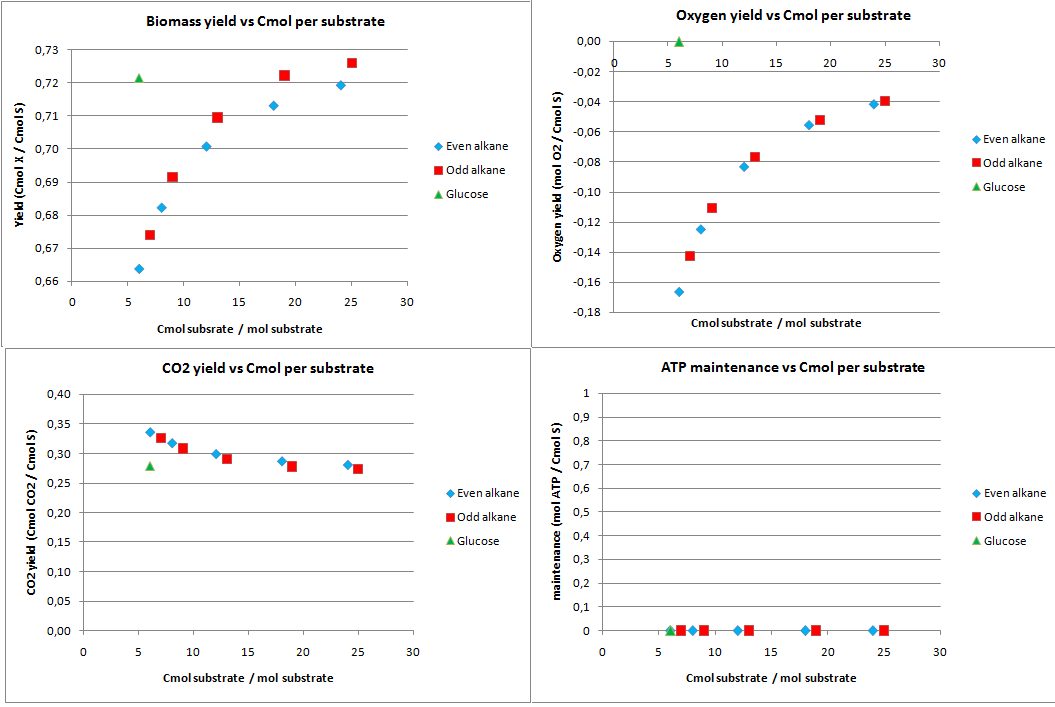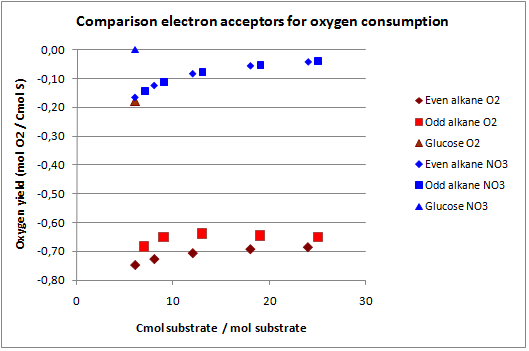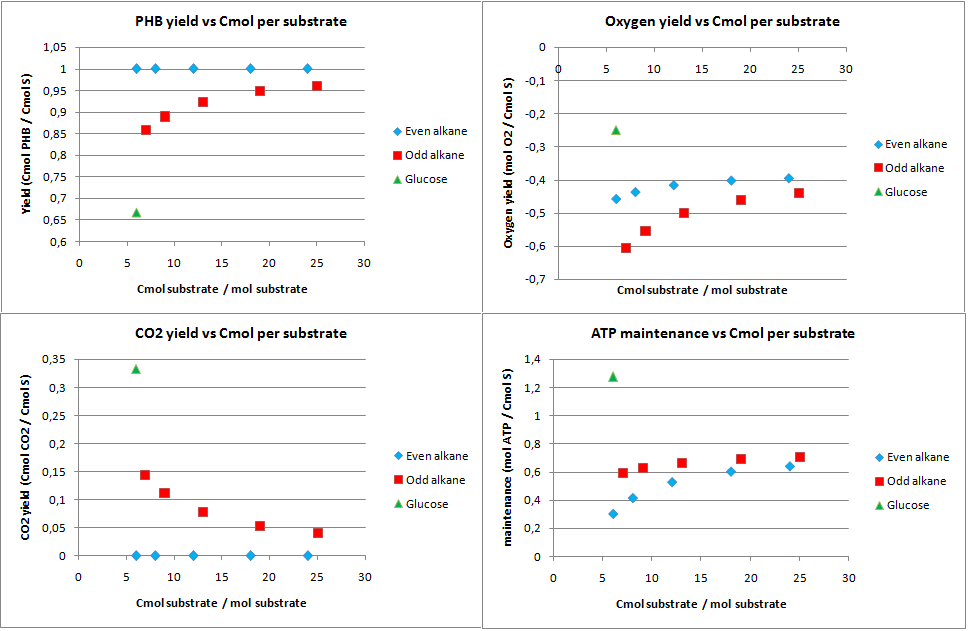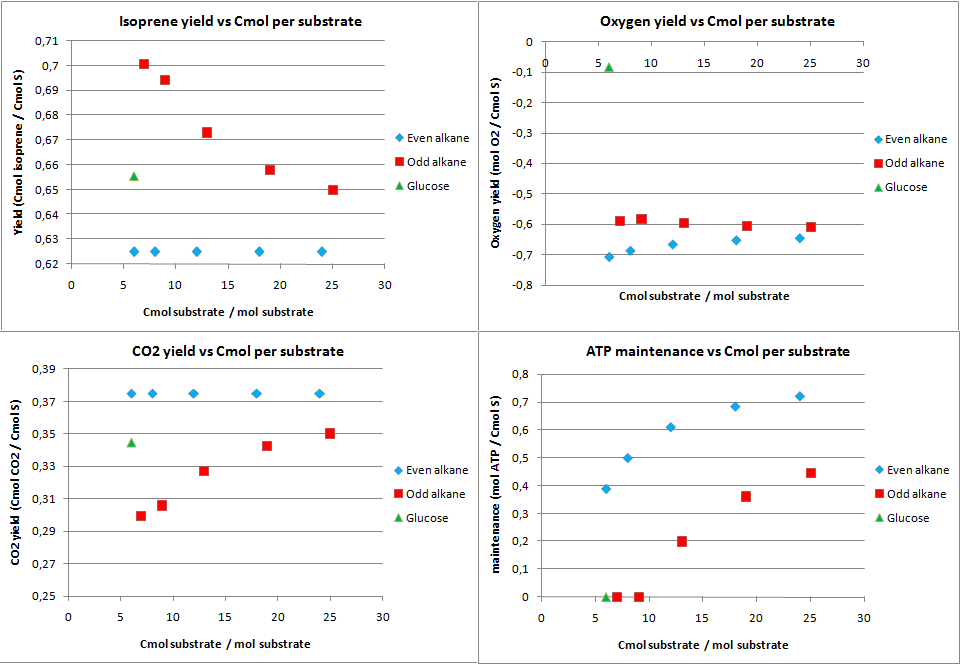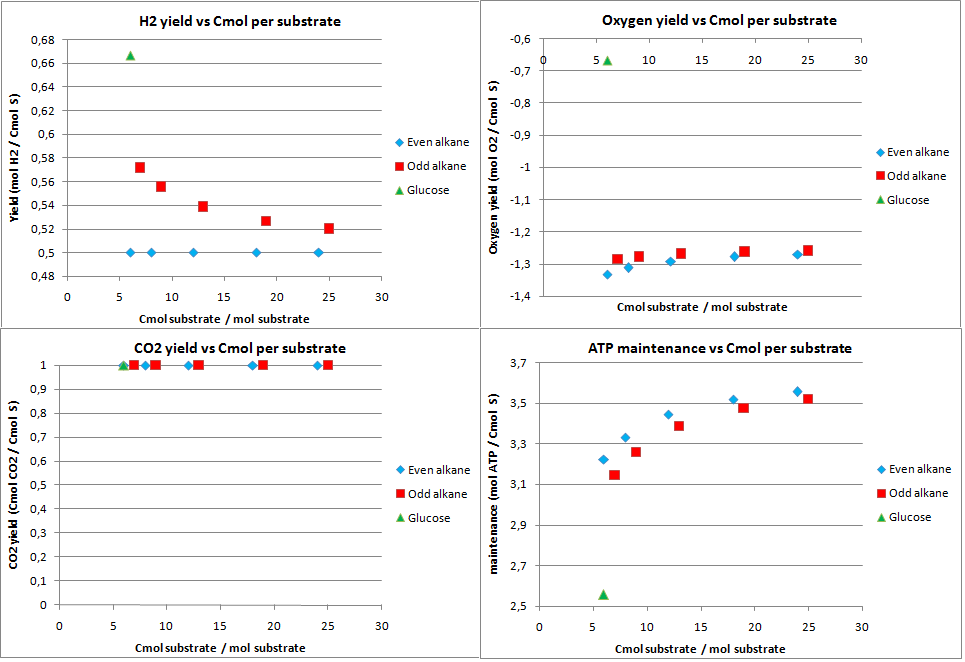Team:TU Delft/Modeling/MFA/results
From 2010.igem.org
Lbergwerff (Talk | contribs) (→MFA results) |
Lbergwerff (Talk | contribs) (→Alkane degradation) |
||
| Line 3: | Line 3: | ||
=Alkane degradation= | =Alkane degradation= | ||
| - | [[Image:Team_TUDelft_Growth_data.png|thumb|800px|centre|'''Figure 1''' – | + | In figure 1 the biomass, oxygen, CO<sub>2</sub> yields are plotted against the amount of Cmol of the product. Also the amount of ATP going into maintenance (essentially getting rid of the ATP) is plotted in figure 1. Glucose has 6 carbon atoms and for the alkanes a range 6 carbon atoms to 25 carbon atoms was taken. These results are for the construct with biobricks for alkane degradation as described by the project description. |
| + | |||
| + | [[Image:Team_TUDelft_Growth_data.png|thumb|800px|centre|'''Figure 1''' – The most important yields from the MFA for alkane degradation]] | ||
| + | |||
| + | The highest calculated theoretical maximal yield for biomass in Cmol per Cmol is achieved with an odd alkane with 9 carbon atoms. Here the yield is 0.853 Cmol of biomass per Cmol of substrate. For even alkanes the theoretical maximal biomass yield is constant at 0.788 Cmol biomass per Cmol substrate. For glucose this value is 0.775 Cmol biomass per Cmol substrate. With the optimazation all the carbon atoms go to biomass and CO<sub>2</sub>, so the CO<sub>2</sub> production is the highest for glucose and the lowest for odd alkanes. | ||
| + | |||
| + | The optimal alkane degradation does however consume more than three times as much oxygen than growth on glucose. Oxygen is often a limiting factor for growth and especially in oily environments the oxygen transfers less easily into the water phase. This additional oxygen consumption originates from the first step in the alkane degradation, which consumes oxygen and the large amount of cofactors that need to be regenerated, which can be seen from the high ATP surplus in the bottom right graph of figure 1. This large surplus of energy is just wasted because of the optimazation, but in reality this energy may be used for something useful. | ||
=NO<sub>3</sub> as electron acceptor= | =NO<sub>3</sub> as electron acceptor= | ||
Revision as of 19:43, 24 October 2010
Contents |
MFA results
Alkane degradation
In figure 1 the biomass, oxygen, CO2 yields are plotted against the amount of Cmol of the product. Also the amount of ATP going into maintenance (essentially getting rid of the ATP) is plotted in figure 1. Glucose has 6 carbon atoms and for the alkanes a range 6 carbon atoms to 25 carbon atoms was taken. These results are for the construct with biobricks for alkane degradation as described by the project description.
The highest calculated theoretical maximal yield for biomass in Cmol per Cmol is achieved with an odd alkane with 9 carbon atoms. Here the yield is 0.853 Cmol of biomass per Cmol of substrate. For even alkanes the theoretical maximal biomass yield is constant at 0.788 Cmol biomass per Cmol substrate. For glucose this value is 0.775 Cmol biomass per Cmol substrate. With the optimazation all the carbon atoms go to biomass and CO2, so the CO2 production is the highest for glucose and the lowest for odd alkanes.
The optimal alkane degradation does however consume more than three times as much oxygen than growth on glucose. Oxygen is often a limiting factor for growth and especially in oily environments the oxygen transfers less easily into the water phase. This additional oxygen consumption originates from the first step in the alkane degradation, which consumes oxygen and the large amount of cofactors that need to be regenerated, which can be seen from the high ATP surplus in the bottom right graph of figure 1. This large surplus of energy is just wasted because of the optimazation, but in reality this energy may be used for something useful.
NO3 as electron acceptor
PHB production
isoprene production
hydrogen production
 "
"

